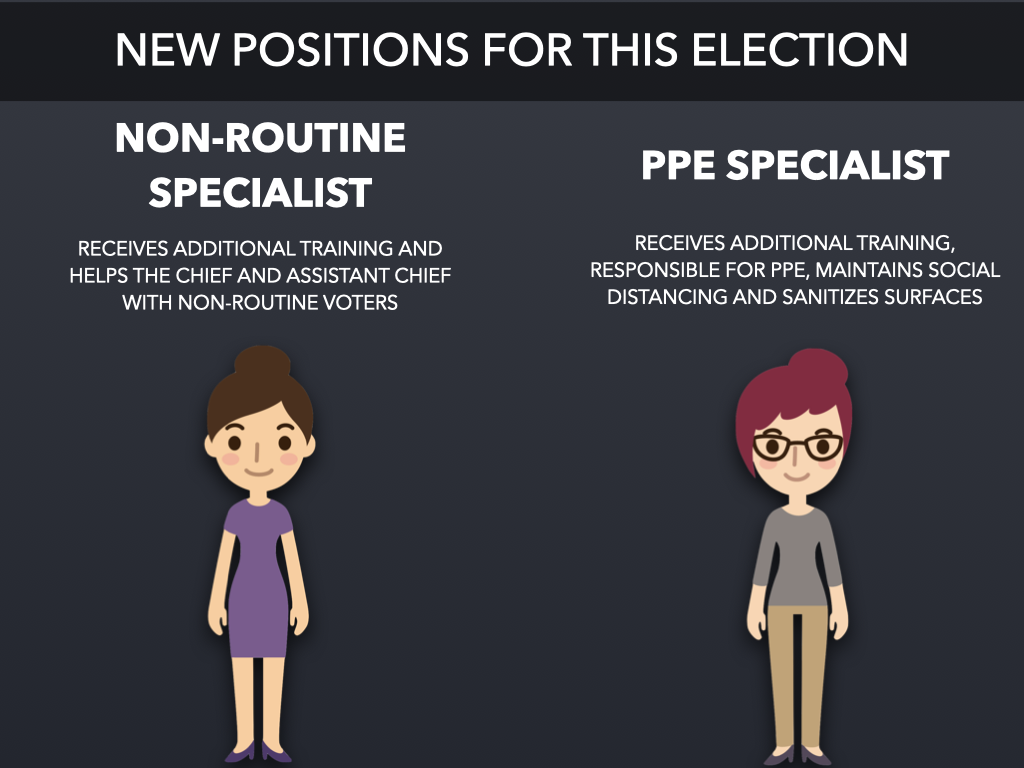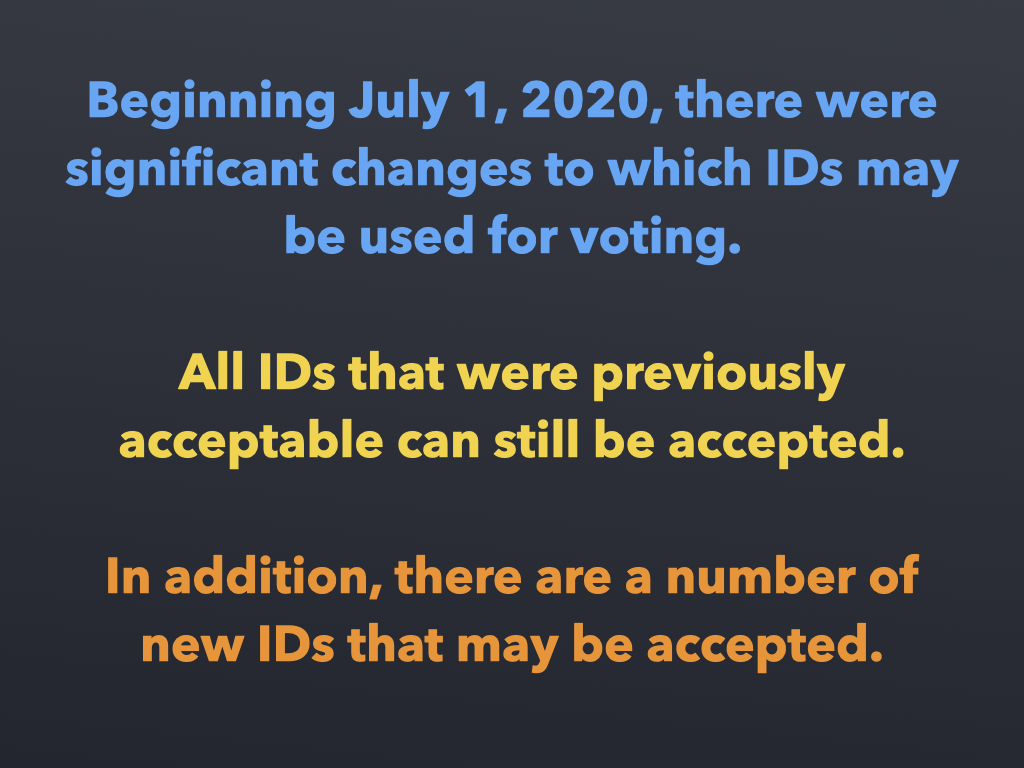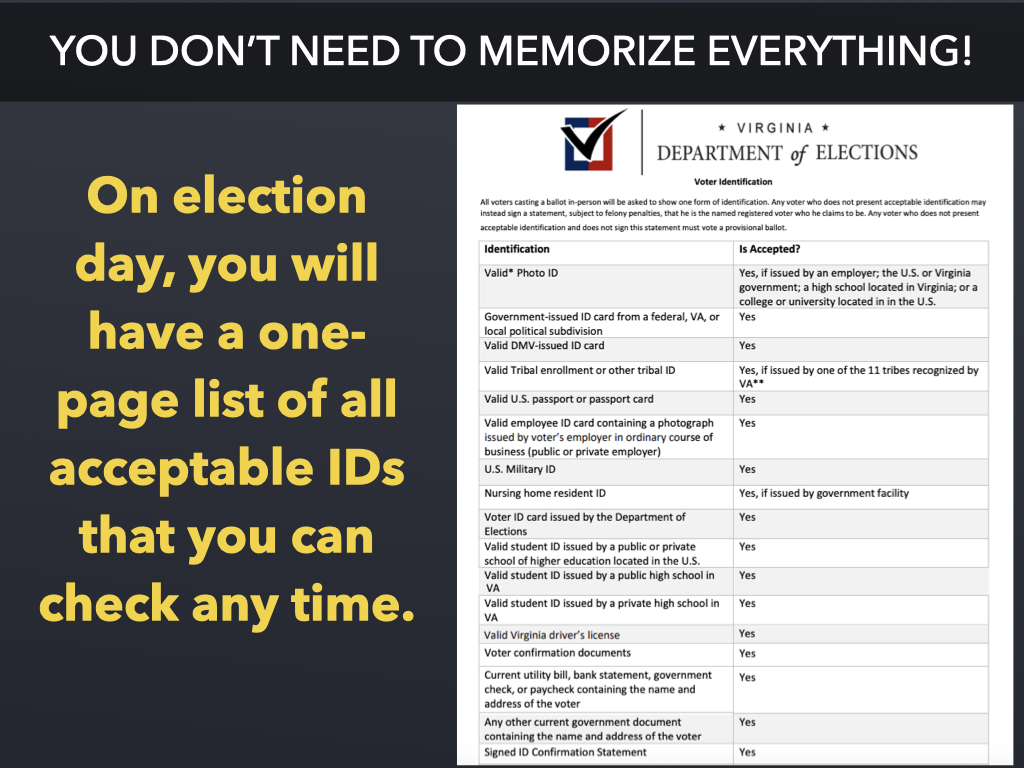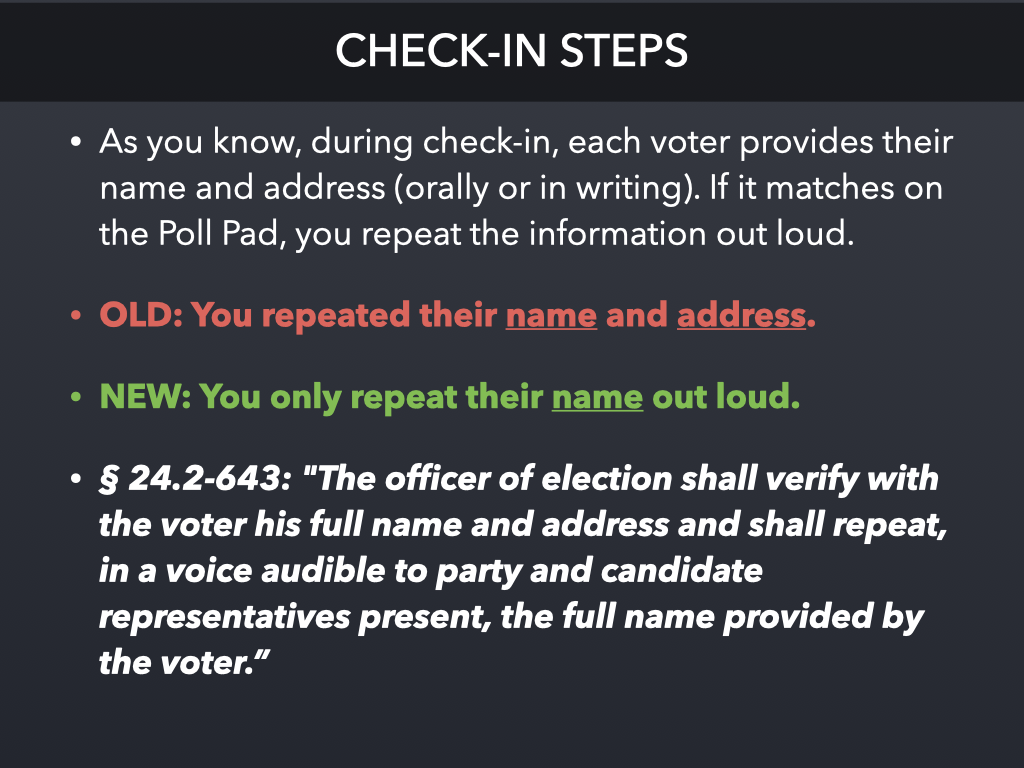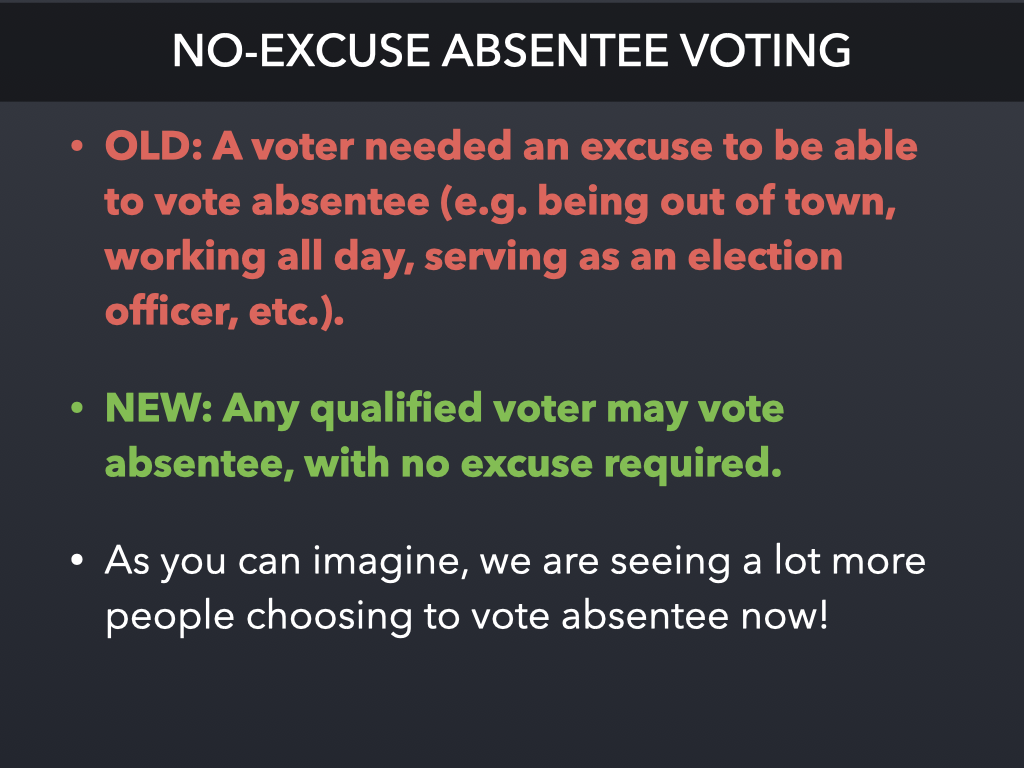Slides Summary
001. INTRO: Changes to Virginia Election Laws
Welcome to the Changes to Virginia Election Laws online training class!
This class will go over all of the recent changes to Virginia election laws that an experienced election officer needs to know about before the November 2020 General and Special Elections.
(If you are a first-time officer, you should review the New Election Officer online training class instead.)
002. INTRO: Overview
First, we will provide an overview of new information you need to know for the upcoming election.
003. INTRO: Class Notes
Review all information in these slides and notes at your own pace.
We will go over all information you need to know, including the new set of acceptable IDs, updated check-in procedures, information about absentee voting, and other miscellaneous changes.
At the end, you must complete a quiz to receive credit for this class.
004. INTRO: Contingency Response Plan for COVID-19
If you are reviewing this material before the November 2020 General and Special Elections, note that we are continuing to prepare and execute our Contingency Response Plan for COVID-19. The plan will be similar to what we did for the June 2020 Primary Elections, which was well-received by more than 95% of all officers according to the post-election survey.
Chiefs and Assistant Chiefs will receive more detailed procedures during their pre-election briefing the week before election day. All election officers will be provided with more information about our Contingency Response Plan for COVID-19 closer to election day.
005. INTRO: Contingency Response Plan for COVID-19 (Continued)
The Contingency Response Plan for COVID-19 currently includes the following measures at minimum:
- Provide each polling place with face masks, face shields, gloves, disinfecting wipes, and hand sanitizer for election officers. (You may bring and wear your own face mask.)
- Provide each polling place with 8 clear acrylic “sneeze guards” to place at each check-in table and other areas.
- Require all election officers to wear a face mask or face shield at all times in the voting area.
- Limit the number of voters in the voting room.
- Require voters to maintain a 6-foot distance from each other and from election officers.
- Provide all training online.
- If any election officer is ill before election day, we will replace them immediately.
- If any election officer appears ill on election day, we will send them home immediately.
006. BASIC INFORMATION: People
Who are the people in the polling place?
-
CHIEF AND ASSISTANT CHIEF: Work together as a team to manage the polling place. They assign and rotate election officers throughout the day. Most importantly, they are trained to handle all non-routine voter situations.
-
ELECTION OFFICERS: Throughout the day, regular election officers greet voters, check-in voters, issue ballots, and direct voters to mark & cast ballots. Some precincts may have Language Officers, who perform all regular officer duties and may also assist voters who speak a different language, such as Spanish, Vietnamese, or Korean. (All Language Officers have been assessed for their language skills.)
-
HIGH SCHOOL PAGES: Only serve in November elections. They may help in many ways, but they are not registered voters and may not operate or supervise use of voting equipment. However, the Code of Virginia does allow Pages to help setup voting equipment before polls open and count unmarked ballots.
007. BASIC INFORMATION: New Positions for this Election
There are two new positions for the November 2020 General and Special Elections.
-
NON-ROUTINE SPECIALIST: All precincts will be assigned one Non-Routine Specialist. This officer will receive additional training on non-routine voter situations and provisional ballots and can help the Chief and Assistant Chief as needed throughout the day. However, the Chief and Assistant Chief are still the primary individuals in charge of the precinct and have the final say on how to handle any non-routine voters.
-
PPE SPECIALIST: All precincts will be assigned one PPE Specialist. This officer will receive special training on social distancing requirements and PPE supplies (Personal Protective Equipment). This officer will be responsible for ensuring that all social distancing signs are posted, extra tables are placed in front of each check-in table for social distancing, social distancing signs are posted on the floor, and that all election officers and party observers wear a face covering or face mask at all times when they are at their work station and/or in the voting room. This officer will also be responsible for managing the use of PPE supplies and ensuring that items such as single-use pens and single-use privacy folders are not recirculated or used by a second voter. This officer will also be responsible for sanitizing voting booths, check-in tables, and all other surfaces throughout the day.
008. BASIC INFORMATION:Polling Place Etiquette
As an election officer, it is vitally important to always be professional and polite in the polling place. Always ask before assisting a voter - sometimes, they may not want assistance. Be mindful of your communication at all times.
For the November 2020 General and Special Elections, you should also always exercise social distancing and keep 6-feet between yourself and all others in the voting room. You will also have face masks, face shields, gloves, sanitizer, and other materials as part of our Contingency Response Plan for COVID-19.
You should never tell a voter that they cannot vote - instead, direct them to the Chief or Assistant Chief, who can offer them a provisional ballot. Do not touch voters without their permission. Avoid all political topics, especially anything that may be on the ballot, whether or not voters are in the room.
Perception is everything, so always be aware of your words and actions. You are representing the county! If you have any questions or are unsure of what is acceptable or not, contact us before or on election day.
We will now go over the biggest change for this election, the set of Acceptable IDs.
The General Assembly met earlier this year and passed many changes to election laws which took effect on July 1, 2020. For us, the biggest change was to the list of IDs acceptable for voting.
To be clear, all IDs that were previously acceptable are still accepted.
However, in addition to those IDs, there are now a number of new IDs that can be used to vote.
011. ACCEPTABLE IDs: Still Accepted and Newly Accepted
There are many IDs that are still acceptable for voting purposes:
- A Virginia driver’s license.
- A United States passport.
- An employer ID, which must have a photo.
- A Virginia voter ID card.
- A Virginia high school ID card.
- Or, other IDs issued by the federal government, the state of Virginia government, or local Virginia government.
In addition to these IDs, there are new items that may now be used to vote:
- A voter confirmation document (e.g. Official Voter Registration Notice postcard).
- A college/university ID, as long they have a campus anywhere in the United States.
- A copy of a current utility bill, bank statement, government check, paycheck, or any other government document containing the name and address of the voter. (“Current” is defined as within the last 12 months.)
012. ACCEPTABLE IDs: Which IDs are Not Accepted
There are also many IDs that you cannot accept for voting.
- A Virginia driver’s license is OK, but an out-of-state driver’s license is not.
- A US passport is OK, but a foreign passport is not.
- An ID from a person’s employer with photo is OK. But other non-government and non-school IDs, such as a credit card or Costco membership card, are not OK.
013. ACCEPTABLE IDs: You Don't Need to Memorize Everything!
Especially with the new list of approved IDs, it can feel overwhelming to memorize which IDs are acceptable and which are not. But don’t worry! On election day, you will have plenty of copies of the 1-page list of all acceptable IDs. You will keep these at your check-in table and reference them as needed.
014. ACCEPTABLE IDs: Sample IDs
Here are some samples of valid IDs. It includes:
- Virginia driver’s license
- Virginia DMV-issued identification card (sometimes colloquially referred to as a “walker’s license”)
- Virginia voter ID (note that it has an issue date, not an expiration date)
- US passport or US passport card
- US federal or military ID
- Work ID with photo
- College/University ID (located in the United States)
- Government ID from a government located in Virginia
Note that many of these IDs do not have an address or expiration date, but they are still valid for voting purposes.
015. ACCEPTABLE IDs: Sample IDs (Continued)
Here are some samples of IDs that are now valid for the November 2020 General and Special Elections following passage of new laws. The list includes:
- A current bank statement (with voter name and address)
- A current utility bill (with voter name and address)
- A current government check (with voter name and address)
- A current government document (with voter name and address)
Note that the Code of Virginia states that all of these IDs must be “current” - this is defined as issued within the last 12 months.
If you’re ever not sure about a particular ID, ask your Chief, Assistant Chief, or Non-Routine Specialist! They receive additional training on how to handle non-routine voter situations. If they are not sure, they can always call our office for help.
016. ACCEPTABLE IDs: Digital Copies of Some IDs are now Accepted
Voters may show you an electronic version of some of the newly acceptable IDs in lieu of a physical version. For example, they could show you one of these documents on their smartphone.
An electronic form of the following documents is acceptable for voting purposes: a current utility bill, bank statement, government check, paycheck, or other government document containing the name and address of the voter.
The Code only requires a copy of these documents; thus, an electronic form of these documents suffice for voting purposes.
017. ACCEPTABLE IDs: About Photos...
Let’s talk about the photos on various IDs.
Before this election, ALL IDs had to have a photo to be valid for voting purposes. This has now changed. The only ID that is explicitly required to have a photo is an employee ID. (Of course, many IDs will have a photo, such as a driver’s license or passport, but only the employee ID is required to have a photo for voting purposes.)
IMPORTANT: Although an employee ID is required to have a photo, you should not question the appearance of the voter (their hair may be shorter or longer, they may have changed their hair color, they may have gained or lost weight, etc.) and you must NEVER ask a voter to remove a face mask or religious face covering to verify their identity.
018. ACCEPTABLE IDs: About Addresses...
What about the address on a voter’s ID? As in past elections, you should disregard it.
You must instead always use the address that the voter provides orally or in writing during the check-in process.
019. ACCEPTABLE IDs: About Expiration Dates...
There is one piece of information that is on some IDs but not others - that’s the expiration date. How do you handle this?
For most IDs, if it does not have an expiration date, that’s OK. As long as it is a valid form of ID for voting, you can automatically accept it. If the ID does have an expiration date listed, then it can be used for up to 12 months past the expiration date. After that, it is no longer valid for voting.
There is one major change to this rule. The Code of Virginia now specifically says that a driver’s license may be used for voting, regardless of when it expired. This is a significant change from past elections, so please keep this in mind!
In terms of the new documents that can be accepted for voting purposes, note that a utility bill, bank statement, government check, paycheck, or other government document must not be more than 12 months old. Don’t forget to look for a date on these documents!
020. ACCEPTABLE IDs: What if a Voter has no Acceptable ID?
If a voter does not present an acceptable form of ID, you should always call the Chief, Assistant Chief, or Non-Routine Specialist! They are trained on alternatives, including:
-
The voter can complete an ID Confirmation Statement. This is a new form that allows the voter to attest to who they are and then vote normally on election day.
-
The voter always has the option to complete a Provisional Ballot and submit their ID later. Some people think provisional ballots are only counted in close elections. Actually, the Electoral Board reviews all provisional ballots and every ballot they accept is included in the official results of the election.
-
The voter can return with an acceptable ID. However, many voters who say they will return later often do not, which is why we encourage Chiefs to still offer an ID Confirmation Statement or a provisional ballot in this situation.
In past elections, voters could come to our office to get a temporary photo ID used for voting. This service is no longer offered as a photo ID is no longer required to vote.
021. ACCEPTABLE IDs: ID Confirmation Statement
This is an example of the ID Confirmation statement. As you can see, it’s a quick form to fill out!
First, the election officer fills in the precinct number and name, the date, and their initials.
Next, give the form to the voter, who signs and prints their name and writes the date. They may also add their birth year and last 4 digits of their social security number.
Again, by completing this short form, a voter would be allowed to vote normally. That means you would issue them a regular ballot, they would mark it at the polling place, and they would deposit it in a DS200 ballot scanner.
022. ACCEPTABLE IDs: Additional Notes
A few additional notes:
The name on someone’s ID does not have to exactly match how it appears on the electronic pollbook. For example, someone’s ID may say “Bill” but the pollbook says “William”. As long as you can reasonably confirm the person in front of you is the person in the pollbook, you may check them in.
Also, if someone provides you a different form of ID, you may not ask for their driver’s license instead just because it’s easier to scan on the Poll Pads. This is against the law! In fact, we often get called in the office when this happens. If you notice a fellow officer doing this on election day, alert the Chief or our office.
Lastly, you may sometimes get voters who are 17-years-old in a primary election. If they are registered and listed in the Poll Pad, they are permitted to vote! The law says that any registered voter who will be 18 by the time of a general election may vote in its corresponding primary.
023. ACCEPTABLE IDs: Send to Chief!
If you’re not sure how to handle a situation, send the voter to the Chief or Assistant Chief or the Non-Routine Specialist! The Chief and Assistant Chief and Non-Routine Specialist are trained to handle non-routine voters and other issues. If they can’t figure it out, they will call our office for assistance.
024. ACCEPTABLE IDs: Which of these IDs is Acceptable?
Let’s do a quick review. Which of these IDs is acceptable? Which is not? Why? Take a moment to think about these questions before you read the answer below.
-
TOP LEFT: This is a work ID, but it does not have a photo. That means it is not acceptable.
-
TOP RIGHT: This is a Maryland driver’s license. This is an out-of-state license, which is not on the list of valid IDs. Therefore, it is not acceptable.
-
BOTTOM LEFT: This is a school ID from the University of North Florida. As this university has a campus in the United States, it is acceptable.
-
BOTTOM RIGHT: This is a voter ID with photo. You may see the 2014 date and think that automatically disqualifies it. However, remember the date that is listed is an issue date, not an expiration date. So this ID is acceptable. for voting.
025. ACCEPTABLE IDs: Which of these IDs is Acceptable (Continued)
Let’s look at two driver’s licenses. One expired in 2016 and one expires in 2025. Which of these is valid for voting?
It’s a trick question: both of these can now be used to vote! Remember, you should completely disregard the expiration date on driver’s licenses. This is the only form of ID that can be used more than 12 months past the expiration date, as specifically written in the Code of Virginia.
026. CHECK-IN PROCEDURES: Intro
We will now go over changes to the steps for checking-in each voter.
027. CHECK-IN PROCEDURES: Check-In Steps
During the check-in process, election officers used to have to repeat a voter’s full legal name and current residential address out loud. The law regarding this has now changed.
Now, you only need to repeat the voter’s name. Just make sure it’s loud enough for party and candidate representatives to be able to hear.
028. CHECK-IN PROCEDURES: ID Confirmation Statement
For voters without an acceptable ID, they can now complete an ID Confirmation Statement which allows them to vote normally on election day. However, how should you record this information on the Poll Pad?
First, the voter completes the form and the Chief should request that you check-in the voter.
Next, it’s very simple: select the “Voter Signed Oath” flag.
(Note: This is the same flag used for Inactive voters. However, there is no change in procedure for Inactive voters. To be eligible to vote, they will continue to use the Affirmation of Eligibility form before being permitted to vote normally.)
We will now go over Absentee Voting information that is helpful for you to know before election day.
030. ABSENTEE VOTING: No-Excuse Absentee Voting
The biggest change to election laws this year involved who could vote absentee before election day. Previously, you had to have a reason to cast an absentee ballot. For example, if you’ve served as an election officer before, you probably remember selecting code 4A on your absentee ballot application form to vote absentee before election day.
Now, the law has changed so that any voter may vote absentee, without any excuse required. As in other states that have made this type of change, we are now seeing a lot more people choosing to vote absentee.
031. ABSENTEE VOTING: In-Person Absentee Voting
If you would like to vote absentee in-person, note that voting begins at one location, the Fairfax County Government Center, on September 18.
If you would like to vote somewhere closer to home, note that voting begins at many other satellite locations on October 14. Dates and hours vary, so make sure to visit our website to confirm locations, dates, and hours before you make a trek out to vote absentee.
Our website is: https://www.fairfaxcounty.gov/elections/absentee/
032. ABSENTEE VOTING: Absentee Ballot Request Deadline
The General Assembly also made a small change to when you may request a mailed absentee ballot. Previously, you had to request your ballot up to 7 days before the election, usually a Tuesday. Now, the deadline is 11 days before the election, which would usually be a Friday.
If you are assigned to serve as an election officer, we strongly encourage you to vote absentee in-person or absentee by mail. While we’ll try our best, there’s no guarantee that we can assign you to your own voting precinct. So if you don’t vote absentee, you won’t be able to leave your polling place and vote on election day.
033. ABSENTEE VOTING: Absentee Ballot Return Deadline
Hand-in-hand with a change to when you can REQUEST a mailed absentee ballot, there’s also been a change for how long you have to return it.
Previously, mailed absentee ballots had to have arrived in our office by 7:00 PM on election day, the same time polls close in all precincts.
Now, however, a voter can postmark their ballot on election day. As long as we receive it in our office by 12:00 PM on the Friday after the election, it will be counted.
It’s important to know this in case a voter comes to your precinct on election day with their absentee ballot in hand. Direct them to the Chief, Assistant Chief, or Non-Routine Specialist, who can advise them of all their options, which now includes mailing it back on election day.
034. ABSENTEE VOTING: Drop-Off Boxes
For the November 2020 General and Special Elections, voters who request a mailed absentee ballot also have the option of returning their ballot in a drop-off box.
Absentee ballot drop-off boxes are available at the following locations:
-
Fairfax County Government Center until November 3 at 7:00 PM. The drop-off box is open 24 hours per day and monitored by camera.
-
Various satellite voting locations from October 14 to October 31 (note that not all satellite locations are open all days - see website for details). The drop-off boxes are open only during voting hours and are monitored by satellite staff at all times.
-
All 243 polling places on election day, November 3. The drop-off box at each polling place will be open during voting hours, 6:00 AM to 7:00 PM, and will be monitored by election officers at all times.
We will provide more information about election day drop-off box procedures to all Chiefs and Assistant Chiefs during their pre-election briefing. We will also email information to all election officers closer to election day.
035. MISCELLANEOUS: Intro
We will now go over some miscellaneous changes and updates that everyone should be aware of for this election.
036. MISCELLANEOUS: Automatic Voter Registration/Updates
In the past, when you interacted with the DMV (e.g. getting a new or updated driver’s license), you had the option of asking for your information to be forwarded to the Department of Elections to update your voter record.
This process has now changed from an “opt-in” method to an “opt-out” method. That means any changes you make with the DMV will be automatically sent to the elections office so we may update your voter record.
This may cause a change in a voter’s precinct. This may affect some voters who show up to the “old” precinct on election day, not realizing their voter registration information has been automatically updated.
A few miscellaneous updates:
-
Sample ballots may now be printed on yellow paper, which was previously banned.
-
You may have heard that Election Day is now a state holiday. This means it is a holiday for people who work for the state government. It is still up to individual employers to decide whether to give this day off to all their employees or not.
-
Just to confirm, polls are open from 6:00 AM to 7:00 PM this election. This is the same as it has always been.
038. MISCELLANEOUS: Updates (Continued)
We’re almost at the end! A few more updates:
-
Election officers cannot be subjected to adverse personnel or employment actions for serving on election day, so long as you gave your employer reasonable notice.
-
Also, the Code of Virginia now says that all election officers must be trained anytime there is a change to procedures or equipment. In Fairfax County, we also begin our new appointment term in 2021, so all officers will have to be re-trained at that time before they can serve again. But once you complete that training, you will be set for the 2-year term, barring any changes to procedures or equipment.
039. CONCLUSION: Intro
We will now go over the final information you need to know to complete this class.
If you need to contact us anytime, call 703-324-4735 or email us.
If you would like to review more training resources, you can find past slides, handouts, and videos on our website at the displayed link.
And finally, as a full-fledged election officer, you can use the Election Officer Portal to indicate your availability each election, enroll in training, and check your precinct assignment.
041. CONCLUSION: Quiz
Congratulations! You have now completed this online class.
To receive credit for this class, you must still take and pass the quiz. You can find the quiz in the Election Officer Portal. Go to the Training tab, scroll down, and look in the bottom-right for a link labeled “Quiz”. If you do not pass the quiz the first time, you can take it again until you pass. If you need any help, don’t hesitate to call or email us.
This class is now complete. Thank you and have a great election day!






